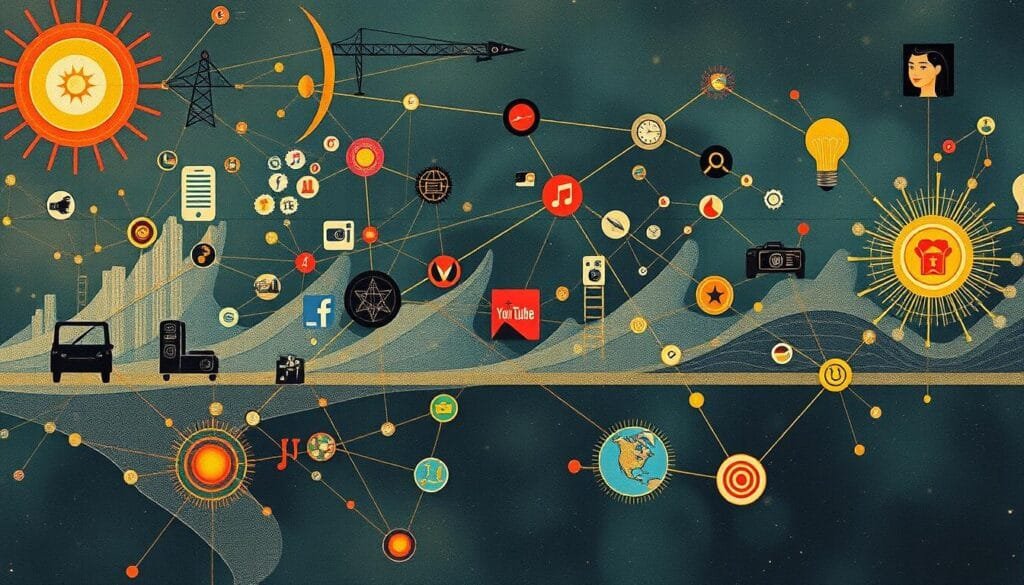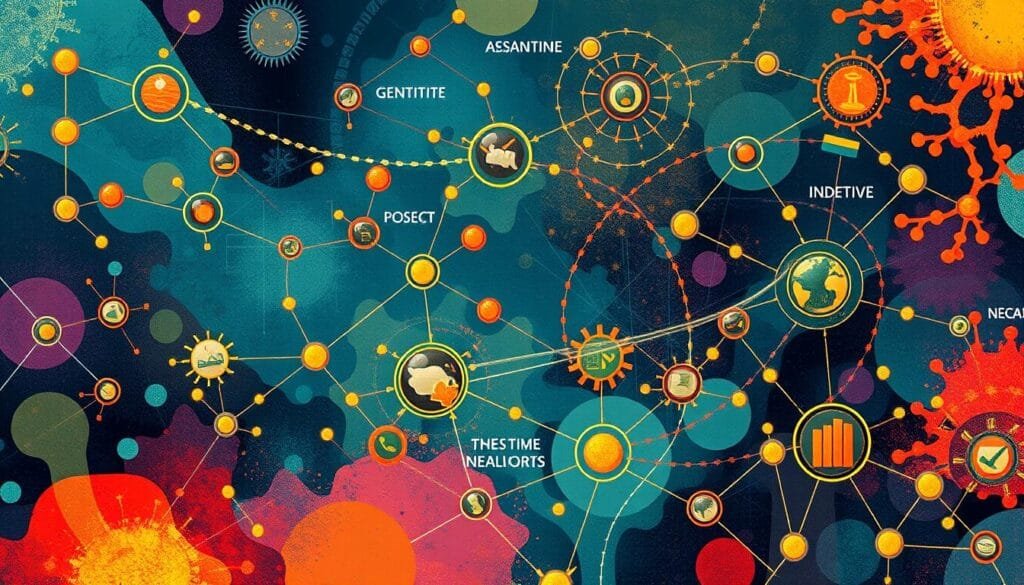Have you ever wondered why platforms like Facebook and LinkedIn are so essential, while others vanish?
Network effects play a huge part in our digital world, shaping the economy. They mean the more people use something, the better it gets. Like a fax machine – it’s more valuable when many people have it. Besides direct uses, indirect benefits grow as more join, affecting many industries.
We will look into what network effects really mean. We will see their history, modern examples, and how firms use them to win. We’ll also see how they influence prices, and their pros and cons for businesses.
Key Takeaways
- Network effects are crucial for analyzing market power, especially in digital markets.
- More users can make a product or service more valuable and competitive.
- Cases like the Microsoft antitrust show the strength of network effects.
- Network effects come from both direct and indirect user interactions.
- Big user groups don’t always keep a platform on top, like MySpace’s fall.
- New tech can challenge advantages that network effects provide.
Introduction to Network Effects
In our world today, knowing about network effects is very important. This idea shows that a product or service becomes more useful as more people use it. It’s a big deal in shaping industries and business plans.
Definition of Network Effects
Network effects mean a product or service gets better as more people join in. Take social media like Facebook and Twitter. The more users they get, the richer the content and the engagement. E-commerce sites like eBay and Etsy show this too. More sellers mean more products to choose from, making it better for buyers.
Direct network effects happen when adding users directly makes things better for everyone. Apple’s iMessage is a good example. Every new user adds value to the platform. Indirect network effects occur in places like Uber and Lyft. More drivers mean more convenience and reliability for riders.
Importance in Modern Economics
Network effects are a big deal in economics. They change market dynamics and lead to situations where the biggest platforms win. For example, eBay becomes the top choice in local markets as it gets more users. Facebook became profitable as it grew, showing how network effects shape business strategies.
Businesses that use network effects grow fast and get a strong position in the market. Etsy is one such marketplace. More sellers bring in more buyers, and the cycle continues. It helps everyone involved.
In conclusion, knowing about network effects helps us understand the success of brands like Uber and Amazon. It shows why they grow so fast and become market leaders.
What Are Network Effects Economics
Network effects economics is key to understanding value growth in industries. As more people use a product or service, it becomes more valuable to every user. This idea is backed by history and proven by examples today, showing its importance in the market.
Historical Context
Network effects began with telephone networks in the early 1900s. By 1908, thousands of local and regional exchanges joined to form the Bell System. This move showed how adding more users drastically increased a network’s value. This is a perfect example of Metcalfe’s Law, which says network value equals the number of users squared (N2).

Between 1985 and 1995, the theory of network effects grew, thanks to economists like Michael L. Katz and Carl Shapiro. They highlighted the “critical mass” concept. This is when a service’s value beats its cost, bringing more growth.
Modern Examples
In the digital world, social media and e-commerce are great examples of network effects. Facebook shows direct network effects, where value grows with each new user. About 90% of its users find value in their connections, proving the need for more users.
Amazon shows indirect network effects. It controls over half of U.S. online sales. Its platform benefits both buyers and sellers, creating a competitive market. The top companies often own more than 80% of the market, blocking new competitors.
Communication apps like Skype show limitless growth potential, only stopped by market limits. These platforms can grow by over 20% a year, thanks to network effects that attract more users as they grow.
| Platform | Network Effects Type | User Growth Rate | Market Share |
|---|---|---|---|
| Direct | 90% | ~70% | |
| Amazon | Indirect | 50%+ US e-commerce | 80%+ |
| Skype | Direct | 20%+ | Indefinite scaling |
The history and current examples of network effects show how user connections change industries. The link between added value and user growth is key for networks to succeed.
Types of Network Effects
Learning about network effects helps us understand why some platforms grow and lead their markets. Mainly, there are two types: direct and indirect network effects.

Direct Network Effects
Direct network effects mean more users make a product or service better. Look at Facebook, with its 2.8 billion monthly users. Each new user makes the network more valuable for everyone on it. Metcalfe’s Law explains this by saying the network’s value is the square of its users.
LinkedIn is another good example. With over 900 million users, its value grows as more people join. In the ride-sharing world, Uber’s story shows strong direct effects. More drivers lead to shorter waits, attracting more users. This cycle helps Uber grow by keeping costs low.
Indirect Network Effects
Indirect effects happen when more users in one group boost value for another group. Video game consoles are a classic case. The more games available, the more appealing the console. This benefits both gamers and game makers.
eBay’s growth illustrates how more buyers and sellers improve the platform for everyone. Bitcoin also gains appeal as more people use it. These examples show the power of growing user groups.
Ride-sharing like Uber sees big indirect effects too. More drivers mean less waiting for riders. This improves Uber’s service and attracts more users. Services like Uber and Lyft rely on these effects for success.
For more on network effects, check out this detailed guide. It dives into how businesses use these effects to get ahead in the digital era.
Examples of Companies Leveraging Network Effects
Understanding how companies use network effects to dominate markets is crucial. They include social media giants, e-commerce platforms, and ride-sharing services. These companies grow because they get more users involved.
Social Media Platforms
Social media giants show how companies with network effects work. Facebook had 2.96 billion users in 2022. Twitter drew in 300 million daily users. TikTok, with over 1 billion users, competes with Instagram’s Reels. This shows a successful network effect business model.

| Platform | Monthly Active Users |
|---|---|
| 2.96 billion | |
| 300 million | |
| TikTok | 1 billion |
| YouTube | 2 billion |
E-Commerce Platforms
E-commerce also thrives on network effects. For example, eBay and Airbnb have grown huge user bases. Airbnb served 140 million guests in one year. They used nearly 6 million global listings. OpenTable grew by getting 50 to 100 fancy restaurants in San Francisco to join. User referrals helped OpenTable grow fast. This is a good example of network effects at work.
Ride-Sharing Services
Ride-sharing services like Uber and Lyft use network effect business models well. Uber had 124 million users monthly in 2022. Lyft’s rider community reached over 20 million. They’ve changed city transport by getting more users to join and keep using their services.
How Network Effects Influence Pricing Strategies
Network effects hugely shape pricing strategies. Companies often start with prices aimed at growing their user base fast. This is because the more users they have, the more valuable their network becomes. This idea is central when they set up their pricing to grow exponentially.
Facebook and Uber started with low or free pricing to draw in users. When their platforms grew, the pricing strategies changed. This was to increase profits. Big platforms like Amazon and eBay show how more sellers attract more buyers. This creates a better value proposition for everyone.
Network effects change prices in many industries. For example, Uber became more useful as more drivers and riders joined. This made a cycle that kept making Uber stronger. Social networks like Facebook gained a lot from more users. More content and engagement made these platforms more valuable. This helped them optimize their prices.
One key part of network effects is how spreading out costs works. As a company grows, it can serve each user more cheaply. This makes the service more appealing. For instance, Uber adjusts prices based on demand but keeps them competitive. This strategy was to gather users from the start.
The direct and indirect effects of networks also affect prices. Direct effects mean more users make the product better, like on social media. Indirect effects involve complementary goods. For example, more console sales mean a higher demand for games. Prices need to reflect these different network effects.
In closing, including network effects in pricing plans is crucial. Platforms need to keep tweaking their prices as they grow. This is seen in successful networks like WhatsApp and Facebook Messenger. They managed to keep growing by adding more value for users.
Benefits and Challenges of Network Effects
Network effects are key to modern business success. They shape how companies grow and function. Understanding their benefits and challenges helps us see their full impact.
Advantages for Businesses
Network effects bring many benefits to businesses. One major benefit is rapid growth. As more people use a platform, its value grows fast. This growth helps the platform’s position in the market, creating a cycle that feeds itself.
This growth also improves how users connect and the variety of products offered. For example, on Facebook, more users mean more connections. It shows how a bigger user base can make a platform more valuable.
Another big plus is increased market share. A platform gets more appealing as more people join it. This is clear with companies like Amazon, which connects millions of buyers and sellers. Around 70% of the tech industry’s value since 1994 comes from network effects.
Potential Drawbacks
But, network effects have their challenges, like market saturation. When a platform’s growth slows, keeping its value high is tough. This can make users less engaged and lower the platform’s value.
There’s also the problem of over-reliance on user growth. Companies that rely too much on network effects may struggle if they can’t keep users. The tech sector sees this a lot when user tastes change or new tech arrives.
Strong network effects might lead to monopolistic behavior, too. A single platform can become too controlling, hurting competition. Bodies like antitrust authorities often step in to tackle these behaviors, seen in cases against big companies like Google and Amazon.
Understanding and managing the challenges of network effects is crucial. While they offer great benefits, especially in tech and e-commerce, navigating these waters is key to long-term success.
| Benefits of Network Effects | Challenges of Network Effects |
|---|---|
| Rapid Growth | Market Saturation |
| Increased Market Share | Over-reliance on User Growth |
| Enhanced User Experience | Monopolistic Behavior |
Strategies for Leveraging Network Effects
In our connected world, using network effects well is key to success. Companies need great strategies to grow and last. It’s all about the right time to enter the market and how to grow your user base.
Market Entry Timing
When you enter the market makes a big difference. If you get there early, you can grab lots of users. This makes it tough for others to compete. Google is a huge example, with over 90% of the search engine market, thanks to its early start.
It’s smart to enter the market when conditions are just right. Remember Metcalfe’s Law: a network’s value blows up as more users join. Moving early and fast can make your network way more valuable. Plus, it draws in users and sets up barriers that keep competitors at bay.
User Growth Tactics
After you get into the market at the right time, you need ways to keep growing. Uber and Lyft got more drivers to cut wait times. This made more people sign up, making their platforms better and more popular.
Keeping users happy and coming back is crucial. Netflix keeps 90% of its users by using data to suggest what to watch next. Social media like Facebook and TikTok grow because more user interaction makes them more valuable. Facebook has over 2.8 billion users, showing how strong this effect can be.
As networks grow, it gets cheaper to bring in new customers. This means companies can grow more without spending much more. Plus, each new user adds more value. Look at Uber. More drivers mean quicker, cheaper rides, making it better for everyone.
To do well with network effects, you need to time your market entry well and keep growing your user base. By doing this, companies can stand out, last long, and succeed.
Conclusion
As our exploration comes to an end, we see how big of a role network effects play today. We’ve looked into what they are and why they matter, using examples from the past and present. They’re crucial in industries like software, e-commerce, and ride-sharing, showing their broad impact.
Businesses that use network effects often gain a competitive advantage. This can improve their position in the market and might lead to dominance. Our discussion sheds light on how network effects expand user bases and shape competition in various sectors. With every new user, the utility increases, or value grows through connections between user groups. This dynamic is clear.
Talking about strategy, we saw how timing and user growth tactics are key. Companies must plan carefully to benefit from network effects. They also need to think about pricing to keep growing. This shows how key it is for businesses to understand and use network effects if they want to succeed in the digital world.
FAQ
What are network effects in economics?
In economics, network effects happen when more users make a product or service more valuable. This can give businesses a big edge. It makes them stand out in the market.
Why are network effects important in modern economics?
They’re key because they can lead to one company dominating the market. Companies with network effects grow fast. They change how they price and engage with users.
What is the historical context of network effects?
Network effects started with the early phone systems. More users meant the network was more useful. This idea helps us understand digital platforms today.
Can you provide examples of network effects in the modern context?
Sure. Facebook shows how having more users adds value. Amazon does too, but through a mix of users and services that support each other.
What are direct network effects?
They happen when a service’s value goes up as more people use it. Like on social media, where everyone can connect. This makes the platform more useful.
What are indirect network effects?
These occur when more complementary goods or services boost a network’s value. E-commerce sites get better as more buyers and sellers join.
Which companies have successfully leveraged network effects?
Instagram, eBay, and Uber are great examples. They focus on growing their user base. This helps them lead their markets.
How do network effects influence pricing strategies?
Initially, companies might lower prices or offer free versions to attract users. Later, they can raise prices. They benefit from more users.
What are the benefits of network effects for businesses?
Businesses enjoy fast growth and a bigger market share. They also see their products become more valuable. This builds a strong market position.
What are the potential drawbacks of network effects?
The downsides include relying too much on adding new users. Also, markets can get too full. Keeping a big network going can be tough.
What strategies can businesses use to leverage network effects?
They should enter the market at the right time and attract users quickly. Partnering with others and running big marketing campaigns are good steps. This helps them grow and keep growing.
